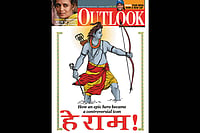That evening, the 81-year-old sound recordist stood at the window, looking out for a woman who had asked him for his story. That doesn’t happen often.
Over the years, he had trained himself to accept the fact that you will be forgotten, diminished and the cacophony of technology will drown the human ingenuity of recording everyday sounds, mixing them and making a language of sounds to complement a story. Like the one where the swing screeches and then whimpers.
The scene is from the 1975 film Sholay; the moment when Sanjeev Kumar’s character sees the dead bodies of his family members lying on the ground. There was no music, no speech. Only that haunting dirge of the swing that someone had sat on before they were shot dead. That was the first time Kuldeep Sood, a sound recordist, had started to invent sound effects for the first 70 mm film.

“For that scene, we got these tarazus (weighing scales) that were used to weigh coal from nearby village. We kept swinging them and that’s how the song of loss without words was born,” he says.
In his apartment in Pali Hill in Mumbai, there are two discs framed and displayed in the living room. They are awards for his contribution to Sholay. There are others too. All arranged neatly on a console.
Sood has chosen to live in a world that he once knew and loved. In his apartment, the songs that he plays are from another era.
The man understands the language of objects and how one can speak for the other. Like how the silver anklets spoke the language of the belt that was dragged over the stones in Sholay when the character Gabbar Singh is introduced. Sounds preceded the characters. Sounds spoke when words didn’t.
Maybe the eerie song of the swing in the film is what will remain. The coin‘s insistence on a memory with the elongated whirling and falling and ultimately stopping. A sound stretched. A language where memories of people and atmospherics sync. He says it was all about syncing, about listening and about substituting one another. Back then, when he went out even for a vacation, he’d carry a recorder and transcribe the sounds of seasons, places, birds.
While sound recordist Resul Pookutty’s 2009 Academy Award for Slumdog Millionaire (2008) made it possible for outsiders to understand the landscape of film sound practice integral to film production and now recognised in a film’s credits, people like Sood live in the sounds of old films and old albums.
Sood hails from Pathankot. Back then, he had wanted to do something nobody in his village had done. He had graduated in Physics and Mathematics and joined the first batch of FTII in Pune to study sound engineering. He then developed a taste for sound recording and ended up as a re-recordist. He worked on many films, won many awards and worked on his own terms.
“It was a time of emotions and you had to highlight it all when mixing sounds,” he says. “These days I can’t understand the story or the lyrics. The story is gone from cinema.”
(This appeared in the print edition as "The Dividends Of Attention")


























